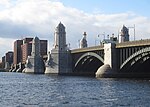Athenaeum Press
Buildings and structures in Cambridge, MassachusettsCommercial buildings completed in 1895Industrial buildings and structures on the National Register of Historic Places in MassachusettsNational Register of Historic Places in Cambridge, Massachusetts

Athenæum Press is an historic building located at 215 First Street in Cambridge, Massachusetts. The structure occupies the entire block between First Street, Second Street, Athenæum Street, and Linskey Way, which was formerly known as Munroe Street. Topped by a statue of Athena sculpted by Adio diBiccari, the building is visible from the nearby Charles River and the Longfellow Bridge.
Excerpt from the Wikipedia article Athenaeum Press (License: CC BY-SA 3.0, Authors, Images).Athenaeum Press
First Street, Cambridge
Geographical coordinates (GPS) Address Website External links Nearby Places Show on map
Geographical coordinates (GPS)
| Latitude | Longitude |
|---|---|
| N 42.3642 ° | E -71.0793 ° |
Address
Athenæum Press Building
First Street 215
02142 Cambridge
Massachusetts, United States
Open on Google Maps









